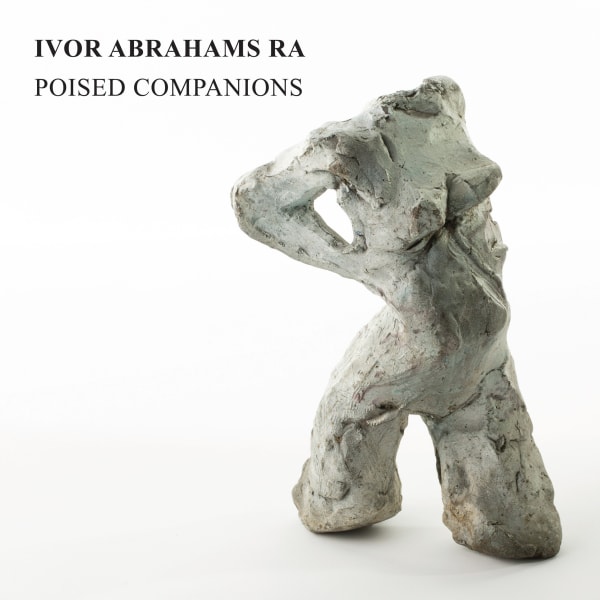Ivor Abrahams British, 1935-2015
‘Our greatest interpreter of the suburban dream’
- Andrew Lambirth
Despite being marginally colour-blind Ivor Abrahams R.A (b. Wigan, 1935 – d. Ramsgate, 2015) was determined to be a painter, but he was also excited by the possibilities of sculpture. ‘His ingenious solution,’ writes Andrew Lambirth in The Life and Works of Ivor Abrahams, ‘was to combine sculpture and colour in various novel and inventive ways, and even to paint and colour his sculptures’.
In the late 1960s exhibiting with emerging British Pop artists, Abrahams quickly found his own path, the bright and colourful Pop imagery became more ironic, sinister and less obvious. This uneasy effect is also compounded by Abrahams’ use of his renowned technique of painted sculpture, which sits in the middle of the two mediums, between 2D and 3D, not quite one or the other. The use of flock paper and photo-collage are also a reaction to his colour-blindness, which only encouraged him to exploit the 3D materials and texture to the full.
The majority of Abrahams sculptures are cast in bronze, its endurance allied to colour, wit and movement. They are sculptures whose spontaneous origin is in drawing, cutting and collage, as much as traditional modelling: ‘Cut-outs in my work are the fulcrum on which everything pivots,’ Abrahams said. Appointed Head of Sculpture at the R.A School, sculpture was how he expressed his ideas best.
Works from his Garden Series have menace, melancholy and wit. Some remind us of foreboding corners in the grounds of once stately homes, others of the suburbs, where evidence of stubborn individuality always delighted him. As Andrew Lambirth has written, he is ‘our greatest interpreter of the suburban dream’. In England the garden, like so much else, is laden with class association and aspiration.
Many of the figures from his post-garden period were cavorting bathers. In some the sea was included, in others, such as Figure from a Seascape, implied. Water had merely been substituted for land. In the 1980s he worked from the live poses of two dancers. Some of these figurative pieces are sensually modelled, most are cropped – ‘comparative incompleteness keeps them free from any kind of illustrative or directly descriptive connotation’. The Owls were a return to bird-loving, idiosyncratic, England. ‘Playing around’ with bits and pieces in his studio, a process extended to encompass computer skills and photoshop.
Ivor’s art reflected the eclecticism of his conversation, it’s surprising diversions and keen eye for absurdity. As James Mayor says, Ivor was ‘a European Rauschenberg, always looking for new ideas or to try a new technique. He was truly innovative’.
-
 Ivor AbrahamsOwl, 2014Decal on steel39 x 25 x 11 cm
Ivor AbrahamsOwl, 2014Decal on steel39 x 25 x 11 cm
15 3/8 x 9 7/8 x 4 3/8 inches -
 Ivor AbrahamsHead of Stairs, 1998Painted bronze29.5 x 16 x 19 cm£ 5,000.00
Ivor AbrahamsHead of Stairs, 1998Painted bronze29.5 x 16 x 19 cm£ 5,000.00
11 5/8 x 6 1/4 x 7 1/2 inches -
 Ivor AbrahamsDancer, 1987Bronze46.5 x 30 x 17 cm$ 6,000.00
Ivor AbrahamsDancer, 1987Bronze46.5 x 30 x 17 cm$ 6,000.00
18 1/4 x 11 3/4 x 6 3/4 inches -
 Ivor AbrahamsReclining Figure, 1986Bronze16 x 35 x 20 cm$ 7,500.00
Ivor AbrahamsReclining Figure, 1986Bronze16 x 35 x 20 cm$ 7,500.00
6 1/4 x 13 3/4 x 7 7/8 inches -
 Ivor AbrahamsArching Figure, 1982-6Bronze14 x 13 x 7.5 cm
Ivor AbrahamsArching Figure, 1982-6Bronze14 x 13 x 7.5 cm
5 1/2 x 5 1/8 x 3 inches -
 Ivor AbrahamsFighting Figures, 1982Bronze43 x 22 x 14 cm£ 9,000.00
Ivor AbrahamsFighting Figures, 1982Bronze43 x 22 x 14 cm£ 9,000.00
16 7/8 x 8 5/8 x 5 1/2 inches -
 Ivor AbrahamsNaiades Series, 1980Monotype45 x 29 cm
Ivor AbrahamsNaiades Series, 1980Monotype45 x 29 cm
17 3/4 x 11 3/8 inches -
 Ivor AbrahamsGarden Suite IV, 1970Silkscreen on paper45.2 x 47 cm
Ivor AbrahamsGarden Suite IV, 1970Silkscreen on paper45.2 x 47 cm
17 3/4 x 18 1/2 inches -
 Ivor AbrahamsFont, 1959Bronze21 x 14 x 11 cm
Ivor AbrahamsFont, 1959Bronze21 x 14 x 11 cm
8 1/4 x 5 1/2 x 4 3/8 inches
-

IVOR ABRAHAMS RA
POISED COMPANIONS 5 Jan - 5 Feb 2016After a close relationship with Ivor Abrahams RA (b. Wigan, 1935 – d. Ramsgate, 2015) for over 40 years, The Mayor Gallery presents an affectionate homage with a selection of...Read more -

IVOR ABRAHAMS RA
THE GARDEN REVISITED 10 Jan - 8 Feb 2013Ivor Abrahams R.A. The Garden Revisited is the latest exhibition with The Mayor Gallery focusing on his Garden period, the exploration of the Suburban through the subject of figureless residential...Read more -

IVOR ABRAHAMS RA
SUBURBAN ENCOUNTERS 1 - 28 Apr 2011Read more -

IVOR ABRAHAMS RA
PAINTED SCULPTURE 4 - 21 Feb 2008Read more -

IVOR ABRAHAMS RA
A PARLIAMENT OF OWLS 14 Jun - 29 Jul 2005Read more -

IVOR ABRAHAMS RA
EXITS AND ENTRANCES 20 Jan - 18 Feb 1999Read more -

IVOR ABRAHAMS RA
POLYCHROME SCULPTURE 1 Mar - 7 Apr 1989Read more -

IVOR ABRAHAMS RA
RECENT DRAWINGS 27 Nov - 23 Dec 1987Read more -

IVOR ABRAHAMS RA
AN EXHIBITION OF SCULPTURE MODELS 7 Oct - 14 Nov 1986Read more -

IVOR ABRAHAMS RA
NEW THEMES 15 Feb - 18 Mar 1983Read more -

IVOR ABRAHAMS RA
FIGURE THEMES 4 - 28 Jun 1980Read more -

IVOR ABRAHAMS RA
RECENT BRONZES AND WORKS ON PAPER 16 May - 23 Jun 1978Read more -

IVOR ABRAHAMS
Recent Sculpture 25 Feb - 27 Mar 1976Read more

























